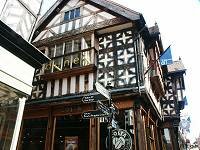A Brief History of Shrewsbury
Early Days
It is believed believed the area was settled in the 5th century by refugees from the nearby Roman City of Wroxeter, but the first physical evidence dates from the 7th century Saxons who named the town "Scrobbesbyrig".
The Normans
The next major developments occurred after the Norman conquest when Roger de Montgomery founded the Castle (1074) and the Abbey (1083). The castle was built on a defensive site occupying the only land entry into Shrewsbury. The rest of the town being enclosed by a loop in the River Severn. Later the settlement was walled for added protection, the remains of which can be found throughout the town, most notable on the side of the town gardens alongside the river.
The Welsh Conflicts
Over the next two hundred years the Welsh made repeated attempts to capture the town. The most notorious being Llywelyn II who after many years and many battles was killed in 1282. A year later his brother David was also defeated and brought to Shrewsbury where was hung, drawn quartered on the High Cross on Pride Hill. His body parts were dispersed around the country and his head sent to the Tower of London.
The First English Parliaments
Edward I was a regular visitor to the Shrewsbury area and it is believed that he convened the first English Parliament at Acton Burnell Castle in 1263. Further meetings took place at the Chapter House in Shrewsbury Abbey.
The Battle of Shrewsbury
One of the bloodiest battles in English history took place just north of the town. The Battle of Shrewsbury in 1403 saw the death of over 6000 soldiers over a period of just three hours.with bodies strewn over a three mile area. Shakespeare immortalised the events in his Henry IV plays. The site has been designated as a heritage area and can be visited, as can the nearby memorial church. The best known fatality of the battle was Harry Hotspur. His dead body was also brought to the High Cross, beheaded and quartered. This Cross is a marker for many slayings and today you can see on the wall of Barclay?s Bank across from a replacement cross a plaque telling of all the executions.

Shrewsbury Street Scene
|
The Civil War
In 1642, at the start of the English Civil War, Shrewsbury was a Royalist stronghold, but not very well defended and so was very quickly overwhelmed by the Roundheads. The town then remained in Roundhead hands until the Restoration of the Monarchy in 1660.
The Industrial Revolution
Despite the proximity of Ironbridge, the industrial revolution had little effect on the character of Shrewsbury - it remained essentially a country market town. Thomas Telford did leave some marks on the town, for example he "modernised" the castle and drove one of his roads through the middle of Shrewsbury Abbey grounds! In 1809 Charles Darwin was born in the town and was subsequently educated at Shrewsbury School before moving on to University.
Origin of the Shrewsbury Name
Scrobbesbyrig
The original Saxon settlement was named "Scrobbesbyrig". It is thought to have been derived from two Old English words - ?scrubb?, meaning be scrubland and ?burh? which means fortified place.
Thus it is the fortified place in the scrubland, probably referring to the nearby plains which in Saxon times were sparsely populated with alder trees, especially in the boggy regions alongside the River Severn.
Shrewsbury
Over the years this became corrupted to Shrewsbury, which nowadays is pronounced usually in two different ways:
?Shrows-bury? or Shroos-bury?. Both variations seem to have equal merit amongst the townsfolk, so prepare for a good debate if you choose to discuss the subject with a group of locals!
Salop
You may occasionally find the town referred to as "Salop", particularly in historical records or publications. In fact Salop is the original name of the county of Shropshire, which of course includes the town of Shrewsbury. Locals will still often describe themselves as Salopians as do students past and present from the Shrewsbury Boys School.
|


